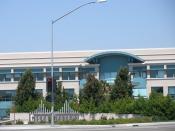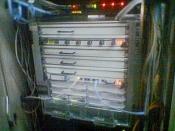1. Cisco's Business and Market
A) What are their main products and what do the products do?
Cisco Systems business market is networking equipment and network management tools for the Internet. Within this market, Cisco Systems main products are routers and switches. A switch is a piece of hardware that joins multiple computers together within one local network or LAN. Switches take incoming data packets and determine the source and destination device of that packet and then forward it appropriately. By delivering packets of data to the device it was intended for, a network switch conserves bandwidth and increases performance.
A router is almost just like a switch but much more intelligent. Routers are used to provide internet users with the capability tying computer networks together. Routers act as multilingual translators that enable networks from all over the world to communicate with one another
B) What do the companies use Cisco's products for and which department within these companies buys the products?
Cisco System's products are used within companies for internetworking; this process of internetworking enables computers across businesses to be able to interact with one another.
The process of internetworking can be applied throughout many types and applications of business whether their related tasks are interoffice or across vast distances. Cisco System's products allow for companies computers and networks to communicate with one another. Through internetworking Cisco has also been able to develop the process of digitization which allows the convergence of three of Cisco System's consumers main areas of business; the internet, enabling the transmission of voice, data and video over one network in a more efficient and economical manner.
C) What is the background of the individuals that buy, install and maintain Cisco's equipment?
The typical background of individuals and companies that purchase, install and maintain Cisco Systems equipment is composed of consumers who seek systems which enable internetworking. For the most part these individuals are composed of a wide variety of consumers ranging from technically savvy individuals to those whom are just trying to networking simple household systems. The increasing availability and ease of installation of Cisco Systems products is exactly what enables Cisco to market and sell its products to such a wide variety of consumers.
D) Has the company been successful and give some measures to support your position? What has driven their growth?
Cisco Systems has been very successful due to the increasing need for computers across many businesses and households worldwide. Projections have shown that over a billion individuals will be on the internet by 2007 and as of 2006 already 75% of all internet traffic travels through Cisco Products. Cisco Systems is a consistent Fortune 500 hundred company with revenues exceeding one hundred billion dollars. The main growth of Cisco Systems is directly correlated with the increase of computers in business and households and the use of routers to connect to the Internet. The recent acquisition of Linksys by Cisco Systems will enable Cisco to have their routers in even more households across the world.
2. IT Infrastructure
A) What enterprise system was implemented, for what reasons and why was this done first?
The implementation of an ERP system was developed by Cisco in order to replace all order entry, manufacturing and financial systems worldwide. The implementation of this system was necessary due to the fact that the current system was unable to scale to support Cisco's growth as well as being forceful enough to meet the requirements that management was imposing. It was important for the ERP system to be implemented first because this would require a total overhaul and reorganization of several components of Cisco's worldwide corporation.
B) Describe the technology infrastructure chosen for clients and for servers using the conceptual architecture for HW and SW. What was chosen for the network?
The technology infrastructure chosen for servers was UNIX. The database level used Oracle and Transmission Control Protocol / Internet Protocol was used for the worldwide network. The local area network uses Window 2003 Server at the LAN level. Client use was comprised of Toshiba and HP computers. Each computer had voicemail, e-mail, meeting scheduling software, desktop and server operating systems, and office productivity suites.
C) Was this a good set of choices and why?
Cisco's decision to choose the technology infrastructure for its clients and servers was a good decision. The use of UNIX is suitable for Cisco as it can be used as a multitasking, multi-user, network-managing operating system. Secondly, the choice of Oracle will enable Cisco to maintain the quality of the data in an organization's database, create new databases and applications. Lastly, a Windows NT is yet another component that provides the ability to multitask and manage client/server networks on PCs with high-performance computing requirements.
3. The CRM approach
A) For customer service what was provided to the customers and what were the benefits?
Cisco implemented a web-based customer service center. This site had many benefits for Cisco. First and foremost it offered 24/7 trouble-shooting for customers. This improved customer satisfaction. They also implemented a program called the "Critical Account List". This is where an employee that could not help a customer post the problem on an intranet based site that is reviewed daily. Cisco then would contact the customer as soon as possible, and help them with their problems. Because Cisco took extra steps to improve customer service their customers have continued to be loyal and help the company grow.
B) For sales what was provided to the customers and what were the benefits?
A web based system was also created to sell Cisco's products online. Customers were for the first time able to purchase Cisco's products online, and at any time of the day all over the world. Cisco benefited an enormous amount from the online sales. They went from only 2% of there revenue coming from online sales in 1996 to 92% of the revenue in 2001. This has helped Cisco grow tremendously by being able to easily sell their products all over the world by a click of a button, and has also played a large role in increases revenues and market share.
C) In both cases what technologies were needed for the customers to access these applications? Why did that approach work well for their particular customer/user base?
To access these applications, all that is needed is a computer with a connection to the Internet. This approach worked well for Cisco because the Internet was readily available to everyone at all times. Also the people that would be looking for the technology that Cisco offered in most cases would have good IT knowledge, because the products that Cisco offers are technology based. Cisco made 92% of its sales through e-Commerce in 2001, so making this available has been a very important move for Cisco.
4. The SCM approach
A) What were the 5 applications/initiatives they rolled out? Briefly describe each and the business benefits of each?
The five initiatives of supply chain management that Cisco Systems rolled out included:
* Single Enterprise: The use of networked applications to integrate suppliers and the production systems forming a sole enterprise effect. The implementation of supply chain management across both supplier and production allowed Cisco's suppliers to manage sections of its supply chain. Due to electronic linking between these systems Cisco and their suppliers were able to offer real time responses to customer demand. Cisco was also able eliminate purchase orders and invoice processing.
* New Product Introductions: Cisco studies revealed that as many as four to five iterations of prototyping were required for new products taking one to two weeks on average to complete. These lengthy iterations created costly time delays and Cisco then developed automated system that were able to more efficiently gather data and reduce the costly time constraints created in the prototyping phase. Cisco was able to simulate manufacturability with the new products introduction phase and catch 98% of all manufacturing errors.
* Autotest: Cisco created automatic tests that utilized minimal labor through standardized product testing. The test programs were made routine and embodied in software test cells. The automation of testing allowed it to be outsourced to suppliers so problems could be identified at the source.
* Direct Fulfillment: Cisco is trying to implement direct customer fulfillment through the elimination of outside partners and additional shipping processes. These additional shipping processes each took nearly three days to complete and through the elimination of these legs Cisco will be able to increase their shipping time ten fold.
* Dynamic Replenishment: Initially, Cisco manufacturers and suppliers did not have access to real time supply and demand information causing costly delays and errors. Compensation for such delays caused Cisco to carry inventory and overhead costs that were too high. This new model allows for real time information eliminating distortion and delays.
B) How did the 5 initiatives depend on each other?
All five of the new initiatives were dependent upon each other due to the fact that they all utilized various components of the inventory and manufacturing process. Each of these processes are essential to the others as they all are dependant upon the integration of both suppliers and manufacturers and limiting the steps of sequential processes that lead to an eventual decline in costs.
5. The Intranet
A) What applications were provided to employees and what were the benefits?
The applications provided to employees consist of web enabled functions that can all be completed through the use of a web browser. EIS and DSS systems are used and entail training to provide employees with distance learning. Secondly, Cisco has produced the Cisco Employee Connection (CEC) which is used to address the unique needs of all its employees providing access to information, tools and resources. Cisco's intranet development is a workforce optimizer revolutionizing the process of old and creating new ones. Through the introduction of these components Cisco Systems has developed an enhanced ability of employee communication as well as added training components. Distance learning modules have allowed Cisco to track the progress and effectiveness of employee learning as well as the areas that will require further support.
B) What applications were provided to managers and executives and what were the benefits?
Cisco management has been provided with applications to help reinforce the fact that the customer is the most important part of the business. Cisco.com has been developed as the centerpiece of this containing comprehensive web based information for customers. The main component of this internet based application is the continuous customer support.
6. Business Strategy
A) Why in addition to the many direct business benefits was it in Cisco's interest to build out this set of applications?
This set of applications was able to not only expand direct benefits but it was also beneficial to the company as they are now able to venture into several areas of expansion. The overall growth of Cisco's can be linked to the adoption of internet based infrastructures. As pioneers in the development of internetworking capabilities, Cisco has come together to change business process and in doing so is able to provide leadership or act a basis for smaller more traditional companies to emulate.
B) Using the framework from Figure 2.4 in the book ("CADIG") list the 3 main strategies that Cisco was pursuing and explain how including the way Cisco used IT.
Cisco's three main strategies Cisco was pursuing include:
* Alliance: Through the use of automatic inventory replenishment by suppliers, Cisco was able to reduce inventory costs and increase sales. In addition, Cisco Systems was also able use a virtual manufacturing alliance to gain agile market leadership. Finally, Cisco saw increases in market share due to online one-stop shopping with partners.
* Innovation: E-commerce programs and application allowed Cisco to gain market leadership. Eventually Cisco would be seen as an internet pioneer through their full use of electronic commerce. Cisco has also recently completed the configuration and order placement for the company's entire product line. As of January, 2001, 92% of Cisco's total revenue base was comprised of internet commerce based revenue. Currently, Cisco operates one of the largest e-commerce sites in the world and through the use of e-commerce applications productivity gains of 60% for Cisco and 20% for customers and sellers are through online commerce.
* Growth: Nearly one-third of Cisco technology has been formed through direct partnership relationships and acquisitions. Approximately 70% of the CEO's from acquired companies remain at Cisco. During 1999, Cisco purchased 19% of one of KPMG's global consulting firm for $1.05 billion. Through partnerships and acquisitions Cisco continues to expand their boundaries and strengthen their company.



Cisco ecomerce
its very useful but again no references
0 out of 0 people found this comment useful.